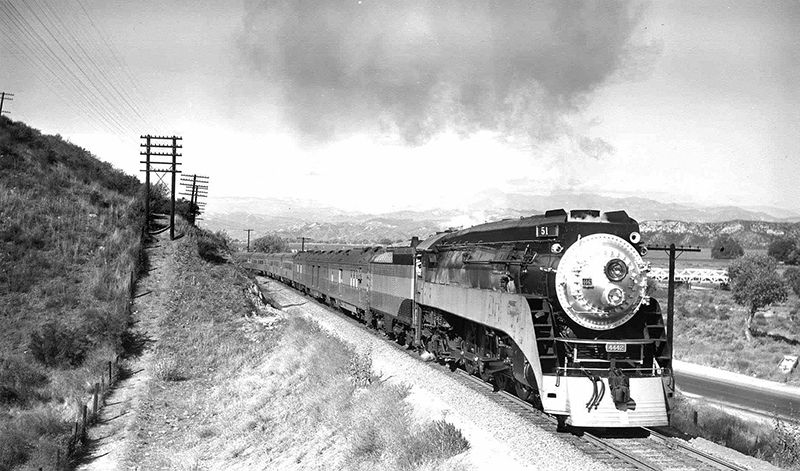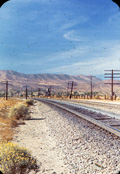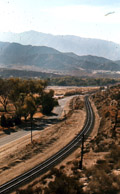|
|


Click image to enlarge.
Postcard showing Southern Pacific No. 4442, a Golden State (GS-4) class locomotive, coursing through Saugus when the train engine was new in 1941. The Bouquet Canyon auto bridge over the Santa Clara River is visible in the distance at right. Veteran UP engineer Jeff Hosford writes (2019; see map below):
I believe this is the curve at Saugus, before tunnel No. 24 was daylighted and the curve realigned. The tunnel would have been just out of sight, behind the hill. The current [2019] location of the curve is the fourth alignment through this area.
Beginning in 1930, Southern Pacific commissioned a fleet of streamlined 4-8-4 locomotives for the Los Angeles-to-San Francisco run, dubbing them "Golden State." The first 10, Series GS-1 (road numbers 4400-09), were built by the Baldwin Locomotive Works of Pennsylvania in 1930 and weighed 448,400 pounds. The next six, GS-2 (numbers 4410-15) were built by Lima Locomotive Works of Lima, Ohio, in early 1937 and weighed 454,400 pounds. They carried a "Daylight" emblem and saw duty on the "Coast Daylight" run. Lima produced 14 more in late 1937, GS-3 (number 4416-29), which weighed 460,000 pounds. In 1941 Southern Pacific ordered 28 more from Lima, Class GS-4, weighing 475,000 pounds with 275,700 pounds over the drivers and a tractive effort of 64,800 pounds. The first 20, numbers 4430-49 (including this one, 4442), were delivered in April and May 1941. The other eight (numbers 4450-57) came in March and May 1942. The GS-4s had all-weather vestibule cabs, a cylinder diameter of 25.5" and a boiler pressure of 300 psi. Lima produced two GS-5s (numbers 4458 and 4459) in 1942, weighing 483,200 pounds, and Southern Pacific wanted more, but the War Production Board would not permit passenger locomotive production. Thus was GS changed to mean "General Service" instead of "Golden State," reflect the fact that Southern Pacific changed their use from passenger to both passenger and freight so that the board would approve new locomotives. Ten GS-6s (numbers 4460-4469) were delivered by Lima in 1943. Two GS-series locomotives survive: 4449, at the Southern Pacific Brooklyn roundhouse in Portland, Oregon (click here for the Friends of 4449), and 4460 at the Museum of Transportation in St. Louis, Mo. Class GS-4 Specifications:
Wheel Arrangement: 4-8-4 Source: North American Steam Locomotives
LW2059: 9600 dpi jpeg courtesy of Jeff Hosford. Online only.
|
The site owner makes no assertions as to ownership of any original copyrights to digitized images. However, these images are intended for Personal or Research use only. Any other kind of use, including but not limited to commercial or scholarly publication in any medium or format, public exhibition, or use online or in a web site, may be subject to additional restrictions including but not limited to the copyrights held by parties other than the site owner. USERS ARE SOLELY RESPONSIBLE for determining the existence of such rights and for obtaining any permissions and/or paying associated fees necessary for the proposed use.



























